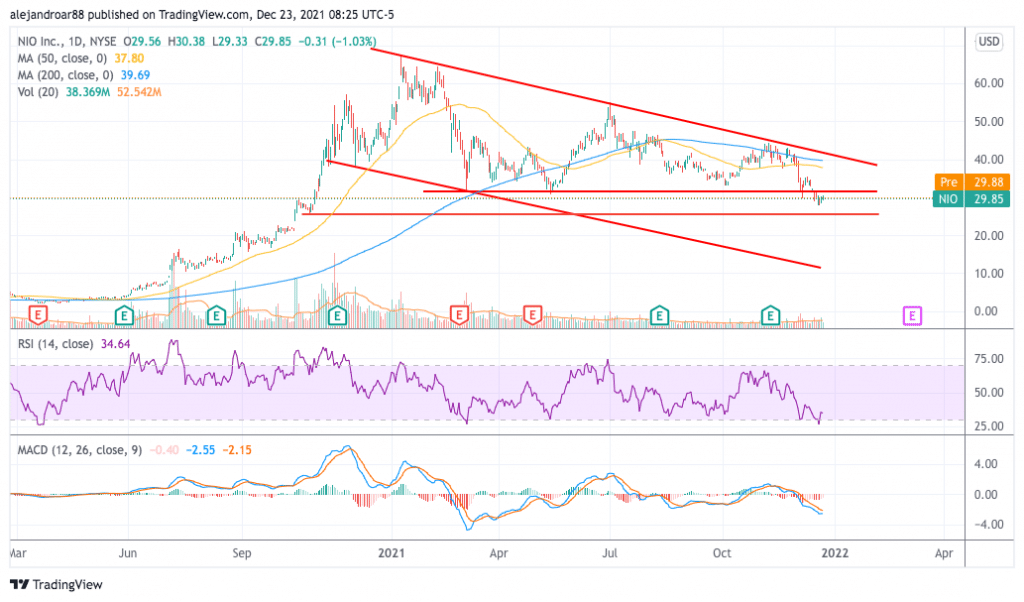Nio Stock Down 24% in December – Time to Buy NIO Stock?
Please note that we are not authorised to provide any investment advice. The content on this page is for information purposes only.
The price of Nio stock has continued to decline in December as the negative momentum that started in early November after the company released its latest quarterly results seems to have accelerated amid the market’s concerns about the potential delisting of Chinese equities.
So far this month, the price has gone down nearly 24% despite the company reporting strong deliveries during November.
On 1 December, the firm reported that it delivered a total of 10,878 units to customers the previous month resulting in a 105.6% jump compared to the same period a year ago. So far this year, the total number of units delivered stood at 80,940 vehicles for a 120.4% year-on-year increase.
Despite this positive report, an announcement from Didi Global (DIDI) involving the delisting of its shares from the New York Stock Exchange (NYSE) rattled the market and caused a drop in Chinese equities including Nio.
What can be expected from this Chinese EV stock as we are about to begin a new year? In this article, I’ll be assessing the price action and fundamentals of Nio stock to outline plausible scenarios for the future.
67% of all retail investor accounts lose money when trading CFDs with this provider.
Nio Stock – Technical Analysis

The price of Nio stock remains on a downtrend following the weakness that most Chinese equities have been experiencing after the government adopted aggressive measures to regulate the activities of large corporations within the country.
As a result of the early-November weakness, the price has dipped below its short-term and mid-term moving averages and it has now lost an important area of support found at the $31.5 level.
A break below this threshold is increasing the downside risk for Nio. The risk of a sharp decline was already elevated amid a fourth tag of the upper bound of the price channel highlighted in the chart and it is now higher as a result of these multiple bearish breaks.
Momentum indicators have not shown signs of a deceleration in their decline as the Relative Strength Index (RSI) posted a lower low recently while the MACD is getting close to its lowest level since the February-March 2021 meltdown.
Moving forward, the outlook for Nio stock is bearish and the next support to watch would be found at the $25.5 level resulting in a 15% downside risk.
Nio Stock – Fundamental Analysis
Nio’s success from the perspective of its top-line performance is hard to dispute The company has managed to grow its sales from $720 million back in 2018 to as much as $2.5 billion last year. Meanwhile, in the past 12 months, the firm has sold $5.1 billion.
Most of those sales are coming from China, meaning that the company still has plenty of room to grow once it manages to expand its operations to reach other countries within Asia and Europe.
That said, the firm remains unprofitable as it has not been able to scale up to the point that it can start delivering positive bottom-line results. However, Nio was cash-flow positive last year and may also end this year with positive free cash flows.
In terms of solvency, the company has only $1.5 billion in long-term debt on assets of $10.7 billion including $6.73 billion in cash, equivalents, and short-term investments.
At its current market capitalization of $49 billion, the company is trading at around 5 times its forecasted sales for 2022. This multiple is particularly attractive for long-term investors but it also leaves room for further short-term declines in case the regulatory situation in China gets worse.
In this regard, the risk of a potential delisting of Nio from the New York Stock Exchange (NYSE) will keep weighing on its outlook unless concerns about this particular matter suddenly dissipate.
Recently, China’s top market regulator – the China Securities Regulatory Commission (CSRC) – stated the following in regards to the government’s position about this matter:
“The CSRC and relevant Chinese regulatory authorities have always been open to and fully respect Chinese companies’ independent choices of overseas listing venues in compliance with relevant laws and regulations”.
They continued: “Recently, some overseas media reported that Chinese regulators will ban overseas listing of companies with VIE structure and demand Chinese companies to delist from U.S. stock exchanges, which is a complete misunderstanding and misinterpretation”.
“The series of policy measures that relevant Chinese regulatory authorities have introduced in the past months with respect to regulating the development of the platform economy are aimed at limiting monopoly, protecting SMEs, safeguarding data and personal information security, and preventing the disorderly expansion of capital”.
The statement closed as follows: “relevant policy initiatives of the Chinese government are not targeted at specific industries or private companies, nor are they necessarily connected to overseas listing of Chinese companies”.
In summary, investors were assured that the Chinese government will not be targeting specific companies to force them to delist their shares from foreign exchanges such as the New York Stock Exchange.
Whether investors believe this or not will likely have a dramatic effect on the valuation of Chinese stock listed overseas including Nio. That said, there is also a risk that the US could unilaterally force Chinese companies out of their capital markets if they do not meet the country’s auditing rules.
If that risk is taken off the table, the valuation of Nio stock is quite conservative at the moment for a company that has plenty of room to grow.






